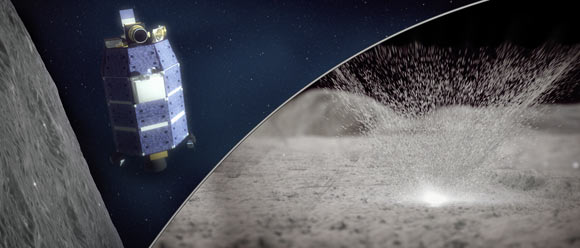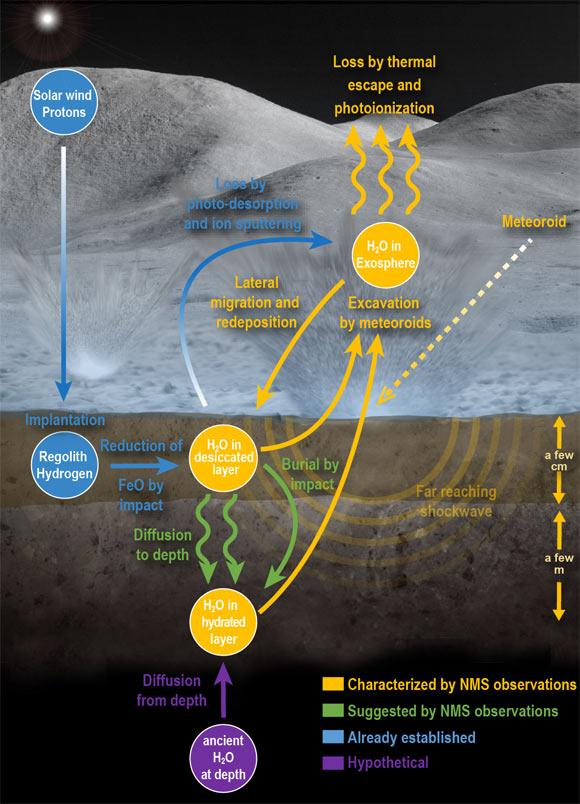Using data from NASA’s Lunar Atmosphere and Dust Environment Explorer (LADEE), a team of researchers has discovered that water is being released from the Moon during meteor showers.

Water is released from the Moon during meteor showers, when micrometeoroid impacts breach the dry lunar surface and eject water molecules from a hydrated layer below. Image credit: NASA’s Goddard Space Flight Center / Conceptual Image Lab.
There’s evidence that the Moon has water (H2O) and hydroxyl (OH), a more reactive relative of H2O.
Models had predicted that meteoroid impacts could release H2O or OH from the lunar surface, but scientists hadn’t yet observed the phenomenon.
“The Moon doesn’t have significant amounts of H2O or OH in its atmosphere most of the time,” said LADEE project scientist Dr. Richard Elphic, a researcher at NASA’s Ames Research Center.
“But when the Moon passed through one of these meteoroid streams, enough vapor was ejected for us to detect it. And then, when the event was over, the H2O or OH went away.”
LADEE orbited the Moon from October 2013 to April 2014 and gathered detailed information about the structure and composition of the lunar atmosphere, or more correctly, the ‘exosphere’ — a faint envelope of gases around the Moon. The spacecraft detected the vapor using its Neutral Mass Spectrometer.

This infographic shows the lunar water cycle based on the new observations from the Neutral Mass Spectrometer on board NASA’s LADEE spacecraft. At the lunar surface, a dry layer overlays a hydrated layer. Water is liberated by shock waves from meteoroid impacts. The liberated water either escapes to space or is redeposited elsewhere on the Moon. Some water is created by chemical reactions between the solar wind and the surface or delivered to the Moon by the meteoroids themselves. However, in order to sustain the water loss from meteoroid impacts, the hydrated layer requires replenishment from a deeper ancient water reservoir. Image credit: NASA’s Goddard Space Flight Center / Mehdi Benna / Jay Friedlander.
To release water, the meteoroids had to penetrate at least 3 inches (8 cm) below the surface. Underneath this bone-dry top layer lies a thin transition layer, then a hydrated layer, where water molecules likely stick to bits of soil and rock, called regolith.
From the measurements of water in the exosphere, the team calculated that the hydrated layer has a water concentration of about 200 to 500 parts per million, or about 0.02 to 0.05% by weight. This concentration is much drier than the driest terrestrial soil, and is consistent with earlier studies.
Because the material on the lunar surface is fluffy, even a meteoroid that’s a fraction of an inch (5 mm) across can penetrate far enough to release a puff of vapor. With each impact, a small shock wave fans out and ejects water from the surrounding area.
When a stream of meteoroids rains down on the lunar surface, the liberated water will enter the exosphere and spread through it.
About two-thirds of that vapor escapes into space, but about one-third lands back on the surface of the Moon.
“We traced most of these events to known meteoroid streams, but the really surprising part is that we also found evidence of four meteoroid streams that were previously undiscovered. These streams occurred on January 9, April 2, April 5 and April 9, 2014,” said Dr. Mehdi Benna, of NASA’s Goddard Space Flight Center and the University of Maryland Baltimore County.
The study was published in the journal Nature Geosciences.
_____
M. Benna et al. Lunar soil hydration constrained by exospheric water liberated by meteoroid impacts. Nature Geoscience, published online April 15, 2019; doi: 10.1038/s41561-019-0345-3







